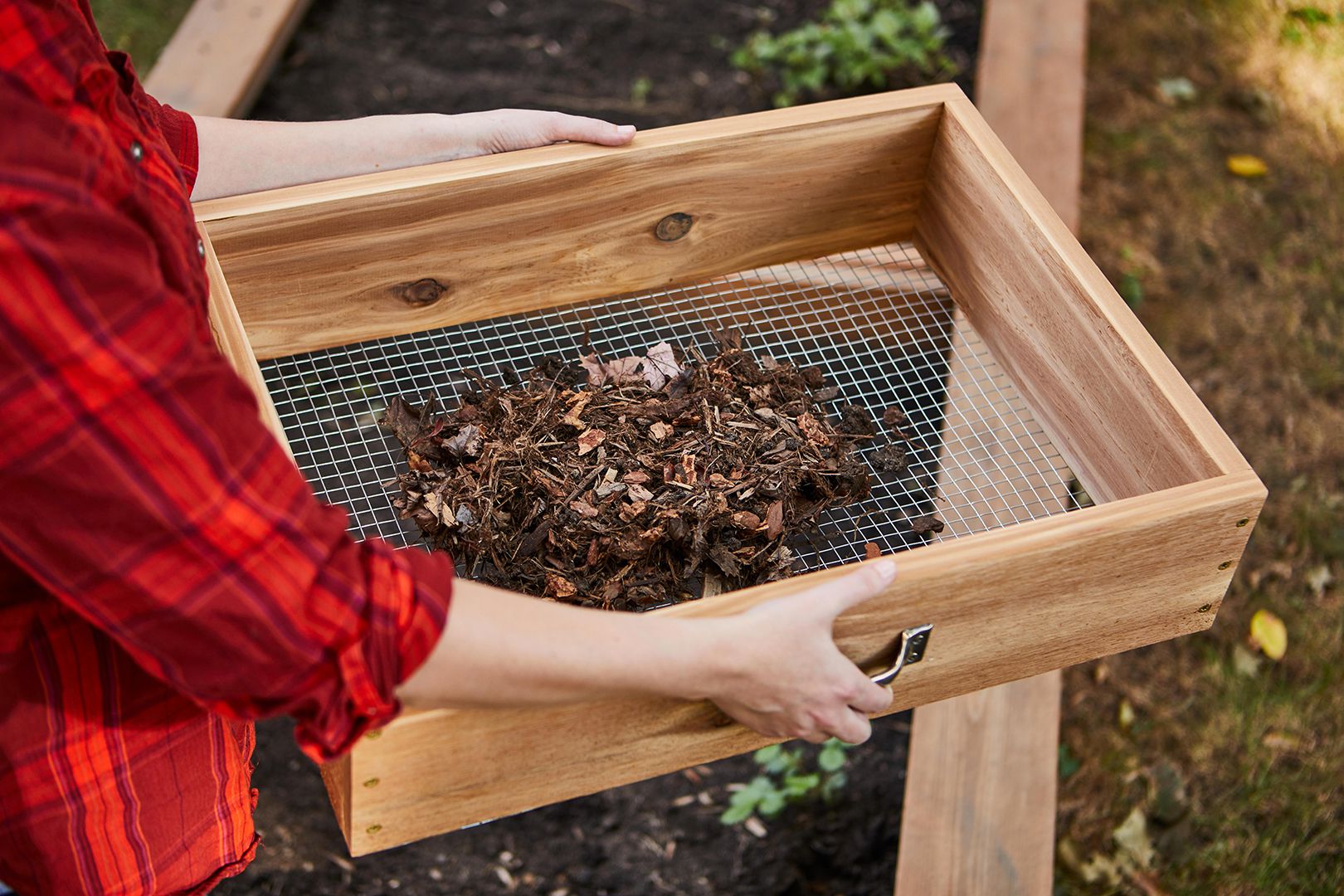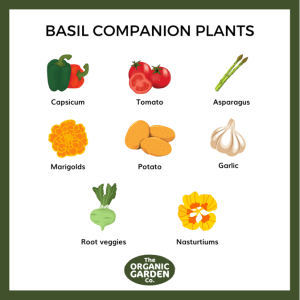To make a soil sifter box for healthy compost, build a wooden frame and attach a wire mesh. Use it to filter out debris.
Creating a soil sifter box is essential for any gardener aiming for nutrient-rich compost. It helps remove large debris, rocks, and clumps, leaving you with fine, crumbly soil perfect for plant growth. A well-sifted compost ensures better aeration and drainage, promoting root health.
Building your own sifter box is simple and cost-effective, requiring basic materials like wood, nails, and wire mesh. This DIY project not only saves money but also improves your gardening results. Follow this guide to construct a durable and efficient soil sifter box that will enhance your composting process and overall garden health.
/compost-on-grate-42cd11a8-c97abcc6b3ef4a26b0e90480ef73ee87.jpg)
Credit: www.bhg.com
Materials Needed
Creating a soil sifter box is a simple DIY project. It helps keep your compost healthy and free from debris. Here’s a list of materials needed to build one. This guide covers essential tools and the best wood types for the job.
Essential Tools
To build your soil sifter box, gather these essential tools:
- Hammer
- Saw
- Measuring tape
- Drill
- Screws
- Staple gun
- Wire mesh
Best Wood Types
Choosing the best wood types ensures durability. Here are some good options:
| Wood Type | Benefits |
|---|---|
| Cedar | Resistant to decay |
| Pine | Affordable and easy to work with |
| Redwood | Long-lasting and strong |
Ensure the wood is untreated. Treated wood can harm your compost.
With these materials, you can build a sturdy soil sifter box. Your compost will be cleaner and healthier.
Choosing The Right Mesh
Choosing the right mesh for your soil sifter box is crucial. The mesh size and material affect how well your compost gets sifted. A good mesh ensures only fine compost falls through. This helps create healthy compost for your garden.
Mesh Size Options
Mesh size determines the size of particles that pass through. Here are common mesh sizes:
- 1/4 inch mesh: Good for fine compost. Removes small rocks and debris.
- 1/2 inch mesh: Ideal for general use. Sifts out larger clumps.
- 3/4 inch mesh: Best for coarse compost. Allows bigger particles through.
Choose a mesh size based on your composting needs. Smaller mesh sizes produce finer compost. Larger sizes work faster but may let some debris through.
Material Durability
The material of the mesh affects its durability. Common materials include:
| Material | Durability | Pros | Cons |
|---|---|---|---|
| Steel | High | Strong and long-lasting | Can rust without proper care |
| Aluminum | Medium | Lightweight and rust-resistant | Less durable than steel |
| Plastic | Low | Inexpensive and easy to find | Less sturdy and can break easily |
Steel mesh is the most durable but requires care to avoid rust. Aluminum is lighter and rust-resistant but less strong. Plastic is cheap but not very durable. Consider your budget and how often you will use the sifter.
Measuring And Cutting Wood
Creating a soil sifter box starts with the right measurements and cuts. Accurate measurements ensure a sturdy and efficient sifter. Cutting techniques help you achieve precise wood pieces.
Accurate Measurements
First, gather your materials. You need a tape measure, pencil, and wood. Measure twice, cut once. This saves time and materials.
- Measure the length of the wood.
- Mark the spot with a pencil.
- Double-check the measurements.
Use a carpenter’s square for straight lines. This tool helps you draw perfect angles.
Cutting Techniques
Use a saw for cutting. Choose between a hand saw or electric saw.
- Place the wood on a stable surface.
- Align the saw with your pencil mark.
- Cut along the line slowly and steadily.
Wear safety goggles to protect your eyes. Keep your fingers away from the blade.
| Tool | Purpose |
|---|---|
| Tape Measure | Measure wood length |
| Pencil | Mark cutting points |
| Carpenter’s Square | Ensure straight lines |
| Saw | Cut the wood |
| Safety Goggles | Protect your eyes |
Follow these steps to cut wood for your soil sifter box. Accurate measurements and cutting techniques will help you build a perfect sifter box.
Assembling The Frame
Creating a sturdy frame is the first step in building your soil sifter box. This frame will hold everything together. Follow these steps to ensure your frame is solid and durable.
Joining Methods
Using the right joining methods is essential for a strong frame. Here are some options:
- Wood Screws: These are simple and effective. They provide a strong bond.
- Wood Glue: Adds extra strength. Use it along with screws.
- Corner Brackets: These help to keep the corners straight and sturdy.
Reinforcement Tips
Reinforcing the frame will ensure it lasts longer. Here are some tips:
- Cross Bracing: Adds extra support. Use wooden strips diagonally.
- Double Layer Corners: Use two pieces of wood at each corner.
- Metal Plates: Attach metal plates to the corners for added strength.
By following these steps, your soil sifter box will be strong and durable. This will help you create healthy compost for your garden.
Attaching The Mesh
Attaching the mesh is a crucial step in making a soil sifter box. The mesh helps separate fine compost from larger debris. Follow these steps to ensure your soil sifter works efficiently.
Securing The Mesh
Place the mesh over the frame of your soil sifter box. Ensure the mesh is taut and covers the entire frame.
- Use a staple gun to secure the mesh to the frame.
- Start at one corner and work your way around.
- Make sure the staples are close together for a firm hold.
Once the mesh is secure, trim any excess with wire cutters. This prevents loose edges that could snag or tear.
Avoiding Common Mistakes
- Using the wrong mesh size: Choose a mesh with small holes for fine compost.
- Not securing the mesh properly: Use enough staples to prevent sagging.
- Skipping edge trimming: Trim the edges to avoid snags and injuries.
Following these tips helps create an efficient soil sifter box for healthy compost.
Finishing Touches
Adding the finishing touches to your soil sifter box is crucial. These steps ensure durability and ease of use. This section will guide you through sanding the edges and applying a protective coating.
Sanding The Edges
Sanding the edges makes the sifter box safe. Sharp edges can cause injuries. Use sandpaper to smooth all rough spots.
- Start with coarse sandpaper (60-80 grit).
- Sand all edges and corners until smooth.
- Switch to fine sandpaper (120-150 grit) for a polished finish.
Don’t forget to sand inside corners too. This step ensures your box is safe to handle.
Applying Protective Coating
A protective coating extends the life of your sifter box. It shields the wood from moisture and pests.
- Choose a non-toxic, outdoor wood sealer.
- Apply the first coat with a brush.
- Let it dry for the recommended time.
- Lightly sand with fine sandpaper between coats.
- Apply a second coat for extra protection.
Make sure all surfaces are well-coated. This step ensures longevity and keeps your compost healthy.
Using Your Soil Sifter
Using a soil sifter box can improve your compost quality. It helps remove debris, rocks, and clumps, making your compost finer and healthier for plants.
Best Practices
To get the best results, follow these practices:
- Choose the Right Location: Place your soil sifter on a sturdy surface.
- Use Appropriate Tools: Use a shovel to load the sifter.
- Shake Gently: Shake the sifter gently to separate fine soil from debris.
- Collect the Filtered Soil: Place a container under the sifter to catch the fine soil.
- Work in Small Batches: Don’t overload the sifter. Work with small amounts at a time.
Maintenance Tips
Proper maintenance ensures your soil sifter lasts longer and works efficiently:
- Clean After Use: Remove dirt and debris from the sifter after each use.
- Inspect for Damage: Check for any wear and tear regularly.
- Store Properly: Store the sifter in a dry place to prevent rust.
- Tighten Loose Screws: Ensure all screws and joints are tight and secure.
- Replace Worn Parts: Replace any worn or damaged parts immediately.

Credit: medium.com
Benefits Of Sifting Soil
Creating a soil sifter box can significantly boost your gardening efforts. Sifting soil offers numerous advantages, making it easier to produce healthy compost and support plant growth.
Healthier Compost
Sifting soil helps remove large debris and rocks, creating finer compost. This improves the texture and quality of your compost. It also allows for better decomposition, resulting in nutrient-rich compost.
Healthy compost promotes a balanced soil environment. It ensures your plants get the essential nutrients they need.
Enhanced Plant Growth
Using sifted soil enhances plant growth by providing a uniform soil structure. This ensures roots can spread easily and access nutrients. Plants growing in sifted soil are stronger and healthier.
Sifted soil also improves water drainage and aeration. This prevents waterlogging and root rot, making plants thrive.
| Benefits of Sifted Soil | Description |
|---|---|
| Healthier Compost | Removes large debris, improves texture, ensures better decomposition. |
| Enhanced Plant Growth | Uniform soil structure, better water drainage, and aeration. |
- Removes large debris and rocks
- Improves compost texture and quality
- Ensures better decomposition
- Promotes balanced soil environment
- Enhances plant growth with uniform soil structure
- Improves water drainage and aeration

Credit: homesteadingfamily.com
Frequently Asked Questions
How Do I Make My Compost Bin Healthy?
Maintain a healthy compost bin by balancing green and brown materials. Turn it regularly for aeration. Keep it moist, but not soggy. Add kitchen scraps, garden waste, and avoid meat or dairy. Ensure proper drainage to prevent waterlogging.
What To Use To Sift Compost?
Use a compost sifter or screen to sift compost. A garden sieve with 1/4-inch mesh works well. These tools remove large debris, ensuring fine compost for your garden. Sifting improves compost quality, making it easier to mix into soil.
How To Make A Compost Box?
Build a compost box using wood or plastic. Drill holes for ventilation. Layer organic waste, soil, and water. Turn regularly.
What Size Screen For Sifting Compost?
Use a 1/4-inch screen for sifting compost. This size effectively separates fine compost from larger debris.
Conclusion
Creating a soil sifter box is simple and rewarding. It helps produce healthier compost for your garden. Follow these steps to make your own. Enjoy richer soil and better plant growth. Start your composting journey today with a homemade soil sifter box.
Happy gardening!





